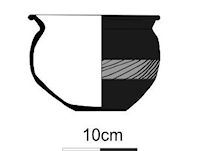
The Romano-British roadside settlement at Catsgore has been well published (Leech 1982) (Figure 7). Late Roman Building 3.10 and associated features are of interest to us here. Building 3.10 was probably later than Building 3.7 (Leech 1982, 22), which was itself thought by the excavator to be later than c.AD 360, on the evidence of a dispersed coin hoard. The interior of Building 3.10 was paved and over this flooring was a thin burnt layer containing slag. Overlying this deposit was a so-called 'occupation deposit' containing two Theodosian coins (AD 388-402) and an amphora-shaped strap-end (Leech 1982, fig. 82.38) of a class (Simpson 1976) associated with the Hawkes and Dunning (1961) type belt fittings. The Catsgore example is best paralleled by an example from Richborough, seen by Böhme (1986, Abb. 21) as a continental import of the period AD 400-450. Taken together this would seem to be good evidence that Building 3.10 was still being used during the early 5th century.

North of Building 3.10 was an external paved yard that appeared to post-date its construction. A coin of AD 364-378 was found on the surface of this yard, which was in turn sealed by another less regular yard surface that butted against the walls of Building 3.10. Over this second yard surface were a number of deposits that contained sherds of several Type 18 bowls and a fragment of a strap-end similar to the example discussed above (Leech 1982, fig. 82.39).
The deposits containing the Type 18 vessels produced a total of 238 sherds of BB1 (weighing 4.220kg). The usual late Roman forms – Types 2, 3, 20 and 25 - were present along with some Type 22 sherds, which were clearly residual. A terminus post quem of AD 364-378 is technically true. However, Building 3.10 is likely to have been at least one or two decades later given that its predecessor, Building 3.7, was constructed after c.AD 360. The second layer of paving outside Building 3.10 must be contemporary with the use of the building, which can be shown to extend into the early 5th century. It is thus likely that the material on the yard surface outside Building 3.10, including the Type 18 bowls, were deposited during the early 5th century.

On the opposite side of the Roman road to Building 3.10 was a structure excavated and published separately. This small rectangular building was unique among the excavated structures in being embellished with a tessellated floor in one of its rooms (Ellis 1984). A deep well was located and excavated just outside this building (Ellis 1984, fig. 10 and table 2). The primary silt in this well contained a coin of AD 341-348, above which two further deposits contained coins of the House of Valentinian (AD 364-378), an NFCC bowl of Fulford's (1975) Type 73 with rosette stamps (AD 350-400+), an OXMO mortarium of Young's (1977) Type M22, three Type 3 BB1 jars (including one with burnished chevron decoration) and a Type 18 bowl (Ellis 1984, fig. 11.7-13) (Figure 8).